How Brands Lose Themselves During Rebranding and How to Avoid It?
Rebranding is more than just a fresh look. If you don’t stay true to your core, it can backfire. The goal is to keep what people love about your brand, while still moving forward and growing.
November 25, 2025

A great rebrand feels like growth. A bad one feels like a loss. Somewhere between boardroom decisions and creative drafts, brands often forget the emotional bonds that made customers care. They replace authenticity with aesthetics — and end up with something that looks new but feels strangely empty.
Rebranding is more than changing visuals; it’s about evolving trust. When that trust is ignored, the emotional core that held the brand together begins to unravel. To rebrand successfully, businesses must learn how to transform without letting go of what made them matter.

The Risk of Rebranding
A rebrand isn’t just a makeover — it’s a message. It tells your audience that something about your story has changed. But if that message isn’t clear, it can cause confusion faster than excitement. People connect to brands through familiarity and trust, and those bonds are fragile during transition.
To navigate it well, brands need more than fresh visuals — they need self-awareness. The rebrand should reflect who the company has become, not who it’s pretending to be. That honesty is what keeps evolution from turning into identity loss. Let’s dive into the blog and see what happens when brands lose themselves during rebrands.
Loss of Brand Equity
Every brand carries years of silent goodwill — the memories, emotions, and trust built through repetition and familiarity. That’s your brand equity. The problem? Many rebrands bulldoze it in one go. A logo that customers have trusted for years suddenly disappears, the tone feels different, and the connection people had quietly starts to fade.
Rebranding shouldn’t mean burning everything down. The strongest brands evolve without letting go of what made them recognizable in the first place. Think of it as updating your story — not rewriting it from scratch. Keep the essence. Keep the emotion. That’s what people remember long after the visuals change.

Uncertain ROI
Rebrands often start with excitement — new designs, fresh ideas, creative meetings that buzz with possibilities. But once the rollout happens, reality sets in: the sales don’t spike, engagement dips, and customers seem… unsure. That’s when teams realize they didn’t define why they were rebranding in the first place.
If you can’t measure what success looks like, you’ll never know if you’ve achieved it. Every rebrand needs clear goals — is it to reach a new market, modernize your image, or fix a reputation problem? Without direction, you end up investing months (and money) into something that looks good but doesn’t deliver.
Brand Confusion
Change too much, and people stop recognizing you. Change too little, and they wonder why you bothered. That’s the fine line brands often stumble over. When customers can’t connect the new look to the old story, they lose the thread — and with it, the trust.
The secret to avoiding that? Bring your audience along for the ride. Tell them what’s changing, and more importantly, why. Familiarity builds comfort. When people understand your evolution, they’re more likely to grow with you instead of drifting away.
Mixed Messaging
This is where most rebrands collapse — when the story inside the company doesn’t match what’s being told outside. The design team has one idea, marketing has another, leadership adds a third — and the result is noise. Customers hear conflicting messages and walk away confused about what the brand really stands for.
Consistency is everything. Every word, visual, and customer touchpoint should echo the same truth about who you are and what you stand for. If your internal team isn’t aligned, your audience won’t be either. A rebrand is only powerful when everyone tells the same story — confidently and clearly.
How to Mitigate These Risks?
Rebranding doesn’t have to mean losing your way. The key is to treat it less like a cosmetic project and more like a long-term relationship reset — thoughtful, intentional, and grounded in clarity. When done right, a rebrand can make your business feel fresh without losing its roots. Here’s how you make that happen.

Increasing ROI Certainty
Rebrands often fail not because the design was bad, but because success was never defined. Before you change a single color or headline, get brutally clear on why you’re doing it. Is it to reach a new audience? Reposition in the market? Fix a perception problem? If you can’t answer that, pause.
Map out what success looks like in numbers and in narrative — new leads, better recall, higher loyalty, whatever matters most to your growth. When your goals lead the design, not the other way around, every decision starts working toward measurable impact instead of vague “freshness.”

Preventing Brand Confusion
People don’t fear change — they fear being left behind. That’s exactly what happens when brands flip the switch overnight without bringing their audience along. The result? A rebrand that feels like a stranger.
Start by communicating early. Share sneak peeks, explain what’s changing and why, and remind your audience what’s staying the same. Keep visual or tonal elements that tie back to your old identity — small details that say, “We’ve evolved, but we’re still us.” When customers feel included in the transition, they don’t get confused — they get invested.
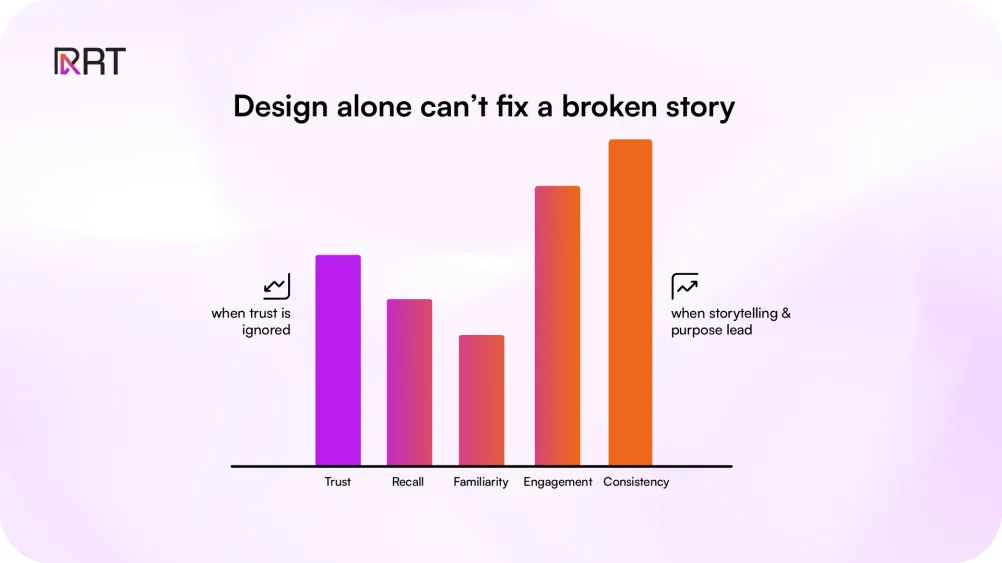
Proactive Media Attention
A rebrand is your chance to control the story before others write it for you. Use that momentum. Announce it with intention — not as a “look at our new logo,” but as a story of growth, clarity, and purpose. Show your team behind it, the insights that drove it, and how it moves the brand forward.
The media loves transformation stories — as long as they make sense. If you connect your rebrand to something bigger (a new vision, expansion, or value shift), you turn what could’ve been a quiet update into a meaningful moment. Don’t wait for attention — shape it.
Maintaining Focus
In every rebrand, there’s a moment where excitement turns into chaos. Too many ideas, too many directions, too many “what ifs.” That’s when you remind yourself — not everything needs to change. The point is to clarify, not reinvent.
Stay anchored to your brand’s truth. If a design, word, or campaign doesn’t strengthen that truth, let it go. The most powerful rebrands are the ones that feel inevitable — like the brand simply grew into who it was always meant to be.
Should You Rebrand or Refresh?
Not every brand needs to start over. Sometimes, what you really need isn’t a total makeover — it’s a tune-up. A brand refresh keeps your essence intact but sharpens how it’s presented. It’s the difference between buying a new wardrobe and changing your entire identity.
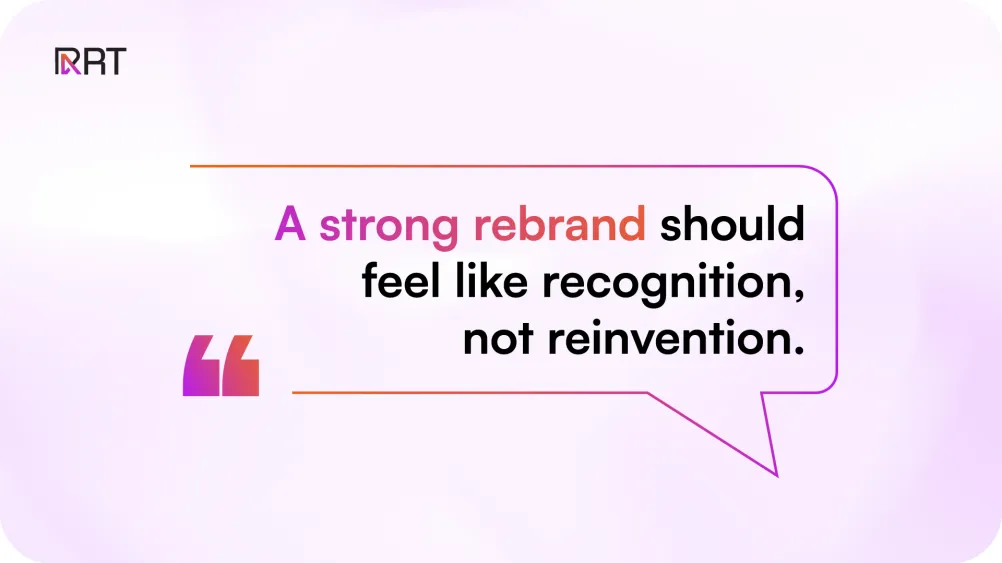
A refresh works when your story still connects but your visuals or tone feel out of step with today’s audience. A complete rebrand, on the other hand, comes into play when your business has evolved so much that the old identity no longer fits. Maybe you’ve shifted industries, entered new markets, or your brand promise has changed entirely.
Here’s a quick snapshot of how the two compare:
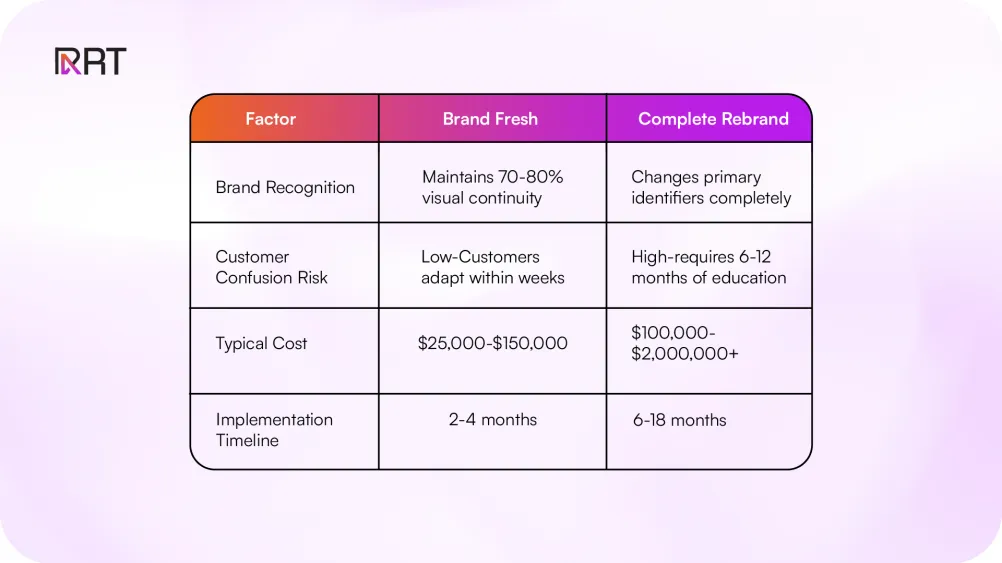
A refresh lets you modernize without breaking the bond you’ve built with your audience — familiar enough to feel safe, new enough to feel exciting. A full rebrand is riskier but can be transformative when done for the right reasons. It demands deeper storytelling, strategic rollout, and clear communication so people understand why the change happened, not just what changed.
The best brands know which road to take. If your foundation is strong, refine it. If it’s no longer serving who you’ve become — rebuild it. Either way, the goal remains the same: evolve without losing the trust that got you here.
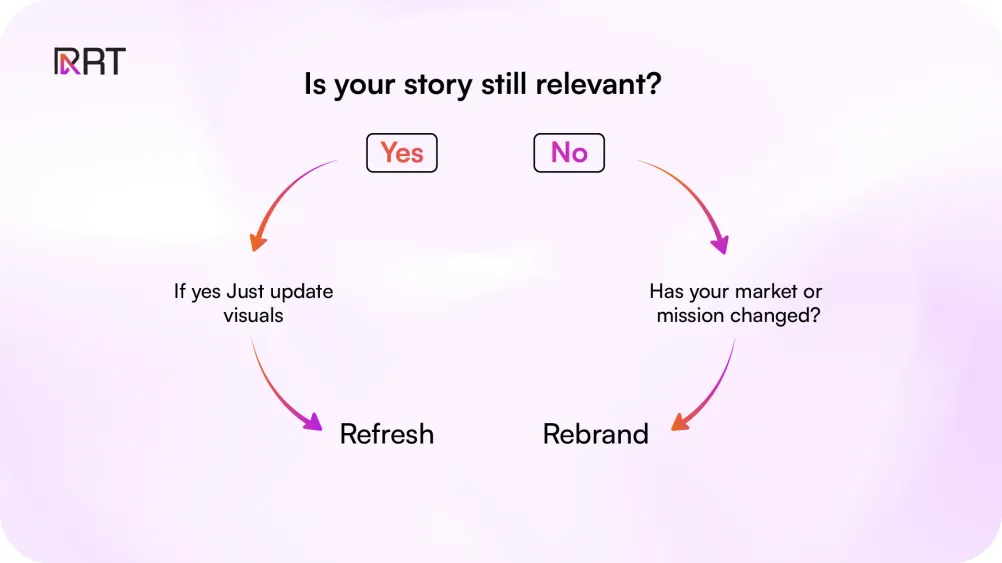
Rebranding Without Losing Yourself
Rebranding isn’t about changing who you are — it’s about showing up as who you’ve become. Every business evolves. The market shifts, people grow, priorities change. A great rebrand captures that evolution without abandoning the story that built your name in the first place.
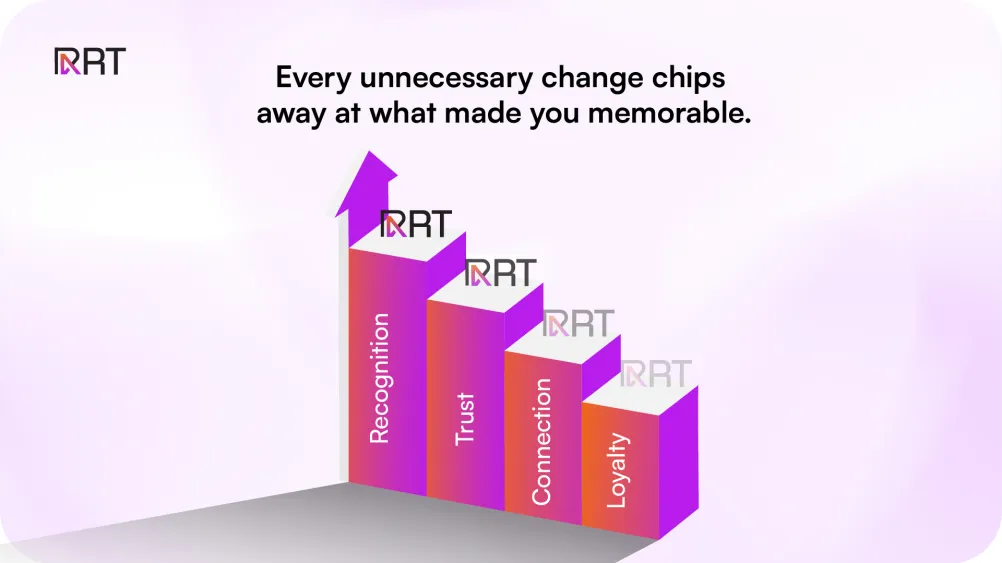
The trouble starts when brands chase “new” instead of “true.” They get caught up in trends, forget their roots, and end up sounding like everyone else. The ones that do it right take their audience along for the journey — they communicate openly, stay grounded in their purpose, and make sure every change feels like a natural step forward, not a break from the past.
A strong rebrand should feel like recognition, not reinvention. It should make people say, “That’s still them — but better.” Because when you rebrand with self-awareness and purpose, you don’t lose your identity. You refine it. And that’s where real brand growth begins.
Frequently Asked Questions
How to rebrand a company without losing customers?
A successful rebrand keeps your audience engaged by evolving your image, not replacing your identity.
To avoid losing customers, communicate changes early and clearly. Keep familiar elements like your tone, logo, or brand colors so people still recognize you. Share the story behind the change — what’s evolving, why it matters, and how it improves their experience. When customers feel included, they stay loyal through the transition.
How to rebrand a company without losing brand equity?
Protect your brand’s emotional core while modernizing its look or message.
Brand equity comes from trust, familiarity, and consistent experiences. Keep the values, messaging, and emotional tone that made your audience care in the first place. A rebrand should refine your identity, not erase it — think of it as evolving your story rather than starting over.
What to consider when rebranding your company?
Clarity, consistency, and communication are key to a strong rebrand.
Before you begin, define your purpose — why you’re rebranding and what success means. Align all internal teams, understand how your audience currently sees you, and make sure your new visuals and tone reflect authentic growth. Finally, plan your rollout carefully to avoid confusion and maintain trust.
Why do companies rebrand themselves?
Businesses rebrand to reflect change — in direction, audience, or identity.
As industries and audiences evolve, companies rebrand to stay relevant and aligned with their goals. It can signal growth, expansion, a new mission, or a refreshed reputation. Done right, it’s a strategic move that shows evolution, not just a design update.
How to rebrand a company?
Start with a clear strategy before you change the visuals.
Effective rebranding begins with research — understanding how people currently perceive your brand, setting new goals, and defining your audience. From there, develop visuals, messaging, and tone that reflect your strategy. Finally, communicate the change consistently across all channels — your website, social media, and marketing materials — so customers stay connected.
How much does it cost to rebrand a company?
Costs vary depending on the size of the company and the depth of the rebrand.
A simple refresh might cost a few thousand dollars, while a full rebrand involving strategy, design, and rollout can reach tens or even hundreds of thousands. The most important part isn’t the budget itself but ensuring every change supports your long-term business goals.
When to rebrand?
Rebrand when your current image no longer represents who you are or where you’re headed.
Common signs include outdated visuals, a shift in your target market, reputation issues, or major growth. If your brand identity no longer matches your company’s evolution, it’s time to rebrand — but do it with purpose, not just for the sake of change.
How long does it take to rebrand a company?
A thoughtful rebrand can take anywhere from several months to over a year.
The timeline depends on how extensive the project is — from a minor refresh to a full identity overhaul. Strategic research, design development, and rollout planning all take time. Rushing the process can lead to inconsistency and confusion, while a steady, well-executed rebrand builds trust and clarity.
What is rebranding a company?
Rebranding is redefining how a company is perceived by its audience.
It involves updating visuals, messaging, or positioning to better reflect the company’s evolution, values, or goals. The purpose isn’t just to look new — it’s to align your brand’s story with what your business has become, creating stronger relevance and trust.
Why companies do rebranding?
Companies rebrand to stay competitive, relevant, and connected to their audience.
Over time, customer expectations change, markets shift, and businesses grow. A rebrand helps a company communicate that growth authentically — through updated design, messaging, and purpose — ensuring it continues to resonate and build loyalty with its audience.

.png)
.png)
.png)
.png)